THERE IS AN UPDATED VERSION OF THIS ARTICLE FOR 2023!
CLICK HERE TO BE REDIRECTED
This is a simple easy guide on how to make the best encodes with the smallest file size in Handbrake without having to know or understand all of the settings. Just copy my settings and you’re done!
**NOTE** – These settings are for Blu Ray Video ONLY – If you want to convert DVD Video see the tutorial HERE.
My Rant – (If your not interested in my rant, scroll down to where it says “Lets Get Started”)
Circa 2000 I got really pissed off at DVD’s. You start watching them, get relaxed and into the story, and when you least expect it they skip or freeze. Sometimes they even crashed completely. In my experience, the damn things were so unwatchable that I swore I would never buy another one again. Blu Ray has been around for a while now, and it started to feel like time to try again with this new technology. I did my research, and found a player that will play all regions (Regional Encoding – one of the stupidist restrictions in the history of technology), and made a somewhat hefty investment in starting a Blu Ray collection. I purchased all of the Marvel Movies, Agents Of Shield, Alcatraz, and I had been hearing a lot about Arrow, so I purchased a Season 1 and Season 2 box set for $80 AUD. I got through Episode 1 and 2 ok, but at episode 3 the old DVD issues appeared. To cut a long story short, EVERY one of the 8 discs in the set crashes about halfway through, and the last 2 episodes on each disc will not play at all. I cant believe the movie studios get away with it. Can you imagine how many bad discs there must be around the world? Again, they drive us to action that they deem illegal.
In order to watch the show I paid $80 for – I was forced to rip the discs to my hard drive. There are plenty of tutorials out there that show you how to do this, so I am not going to cover that here. Once I had ripped the episodes, each file was almost 6GB in file size. I set about trying to reduce the sizes and found thousands of different ideas and methods. It is a topic a lot of people are very passionate about. Factors like TV size, Viewing distance, hardware, drive space restrictions and a plethora of other concerns are all valid. But if you are like me, and just want to reduce your episodes to a more manageable size, whilst retaining most of the quality, here’s how to do it.
Lets Get Started
PLEASE NOTE – This method will produce very nice quality 1080p videos, but may take 2 hours or more to process each hour of video, so my advice is to let run whilst you are sleeping each night.
Once you have ripped your Disks to MKV files with Make MKV, Open Handbrake (You can download the latest version for free HERE) then press the source button and select the file you want to convert, or if you want to do a batch of files, select the folder that contains all of your ripped MKV’s. Handbrake will import them all, but you will only see the first one. Now it’s time to make some adjustments to the settings.
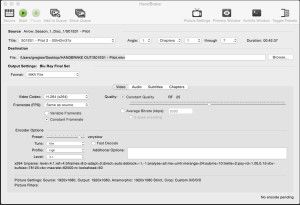 All of your settings should look like the above screen grab – Click it to enlarge.
All of your settings should look like the above screen grab – Click it to enlarge.
THERE IS AN UPDATED VERSION OF THIS ARTICLE FOR 2023!
CLICK HERE TO BE REDIRECTED
1. Set the output format to MKV File
2. Click the button that says “Video”. Make sure the video codec is H.264 (x264)
3. The frame rate should be “Same as Source” and Constant Framerate should be selected.
4. Check Constant Quality and adjust the slider until the RF number goes to 25
5. For the encoder options, slide the preset slider to Very Slow. Trust me, it takes a while, but the quality is far superior, and usually yields a smaller file size. Unfortunately it is a trade off for speed vs quality. Like I said, run it while you are sleeping.
6. Leave “Fast Decode” unchecked.
7. Set Tune to Film
8. Set Profile to High
9. Set Level to 4.1
10. Now click the “Picture Settings” button in the top right side of the window.
![]() A new window will open. Change all of your settings look like this
A new window will open. Change all of your settings look like this
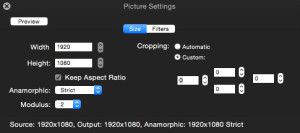 11. Whilst in the picture settings window, click “Filters” and change all of your settings to look like these as well
11. Whilst in the picture settings window, click “Filters” and change all of your settings to look like these as well
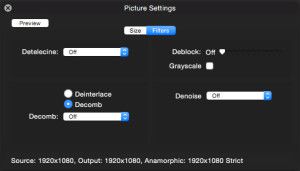 12. Now you can close out the Picture Settings window and select the “Audio” tab in the main window.
12. Now you can close out the Picture Settings window and select the “Audio” tab in the main window.
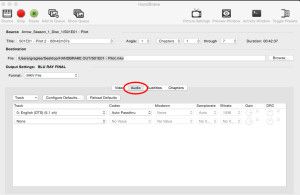 I am a real Audiofile, I love the Dolby Digital and DTS 5-7 channel audio tracks in movies, so I select “Auto PassThru”. But, if regular 2 channel Stereo is ok for you, you can configure that in this area if you want. I figure you are converting a Blu Ray, so you might as well have the best sound quality as well. Just select the Dolby Digital or DTS sound track from the drop down window, and choose “Auto Passthru”
I am a real Audiofile, I love the Dolby Digital and DTS 5-7 channel audio tracks in movies, so I select “Auto PassThru”. But, if regular 2 channel Stereo is ok for you, you can configure that in this area if you want. I figure you are converting a Blu Ray, so you might as well have the best sound quality as well. Just select the Dolby Digital or DTS sound track from the drop down window, and choose “Auto Passthru”
13. Click the “Subtitles” tab and select none
14. Click the “Chapters” tab and make sure “Create Chapter Markers” is un-checked.
15. You are now ready to start encoding. If you are only doing one file, just press the “Start” button and Handbrake will start encoding. If you are doing a batch of files, open the File Menu and select “Add All Titles To Queue”
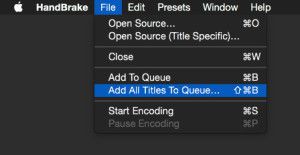 16. Press the “Show Queue” button to see all your files waiting to be encoded
16. Press the “Show Queue” button to see all your files waiting to be encoded
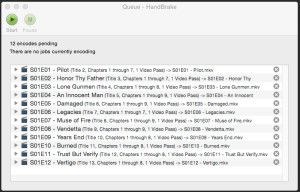 17. Press the “Start” button and your encoding session will begin.
17. Press the “Start” button and your encoding session will begin.
Using this method I have been able to shrink each of the episodes from about 6GB in size down to about 1.3 to 1.5GB in size, retaining the full 1080p resolution and DTS sound track. The picture quality is very nice on my 42 Inch Samsung LCD TV. I play the files off my WD TV Live Hub and connect using HDMI cables. If you have a larger TV and notice some artifacts or “Blocks” in the picture, tweak the RF number slightly to 24 or at most 23. Adjustment here affects file size and quality considerably, so tread carefully and use small increments.
THERE IS AN UPDATED VERSION OF THIS ARTICLE FOR 2023!
CLICK HERE TO BE REDIRECTED


Thank you so much! I was wondering why my video’s audio was getting all messy when I uploaded to Vimeo.
Great article. Thanks much. These settings produce very nice movies!
Why the prohibition on chapter markers? That’s never really explained why the necessity to turn those off.
I can’t seem to get mine to go over the 720/480 ?!?!
One final step, perhaps: how do you save these settings so that they become the default?
Hi Kris – Is your source file larger than 720×480? If it’s a DVD you need to see my other article HERE.
Hi AmRus – Your best bet is to create a new preset ((Preset Menu->New Preset) and save the settings, that way each time you want to use them, you just click the preset, and you are ready to go.
Thanks for all the great info! Is there any reason why it wouldn’t be appropriate to rip to M4P instead of MKV? I’m putting movies on a Plex server, which we use to watch movies at home on our 65″ TV, as well as on iPads for my kids… so far, I’ve ripped all my DVD’s to M4P, but I’m doing my 1st Blu-ray, and I’m ripping that to MKV… just wondering if I could just keep the same format for both Blu-rays and DVD’s.
You can slo jusst click Presets, ‘Set Current as Default’ after you’ve typed in the settings- as I’ve just discovered! Thanks for the help with these settings, was getting massive file sizes without realising why!
Thanks a lot! You have saved me many hours, days and weeks of trying to find the optimal solution.
Can we get an update on the latest version please.
Yes, an update and information on the subtitle settings please.
RF 25 is way off. I used the Handbrake’s default settings at first and the image quality was much better than with these settings. When I used the same video settings than on this page but with RF 18 I couldn’t tell the difference from the actual Blu-ray. But with RF 25 the packaging artifacts were very distracting. It also destroys the grain almost completely.
Aargh, sorry. I didn’t notice you were making MKV files. I was making M4V files from MKV:s with Handbrake to watch with iTunes. That’s what probably makes the difference.
Why do you use RF 25, when many posts say default 20 or 18 is fine?
I started the first step in making the MKV files from my Blue Rays and DVD’s and realized that I forgot to uncheck the subtitles and other audio options I did not want. Now rather than going back to the original disks to remake the new MKV files, would I lose any quality by making the updated MKV files from the old MKV file. I am assuming that that prossess would go much quicker since it is hard drive to hard drive.
My source HD file is aprox 950MB and with these settings the file is aprox. 200MB. Seems to me that the new file is of less quality. When I use the 20 setting vs 25, the file is aprox 600MB and the image looks better. However, the default settings show that the lower numbers are used for SD (18-20) and the higher numbers are used for HD (20-23). This seems backwards. How can less information in a HD file be better? I will continue to lower the number until it matches the original file size or slightly under since I am burning in the subtitles.
I always use the same settings as you, except for the RF, I use 20. Good experiences with that value, but never even tried RF25. Should make the file much smaller though.
@richard – You can remove unwanted tracks with MKVmerge, without any loss pf quality.
Hi Richard, the Reasom I use RF 25 is because I dont want to see any signs of block artifacting – it drives me crazy. I like the picture quality on a large screen to be as close and as clean to the source as possible. In my testing I found that RF 25 gives a much smoother and crisp result, and with the encode priority set so low the file size isnt greately effected as the computer has time and resources to produce a great result.
Hi Greg, I don`t understand your RF25 approach aswell. You sacrifice quality by increasing RF from 20 to 25 and the picture quality is smoother and more crisp? Best RF quality would be 0 as it is lossless.
Reading back on my last reply I havent explained myself very well – What I am trying to say is By setting the processing priority to slow, and giving the computer more time and resources it will do a nicer job, and produce a better result with a much smaller file size – thats why I push the RF to 25, smaller file size. The quality is still good because the encode time is longer.
Thank you, now it makes much more sense for me. 🙂
Thanks for sharing your settings with us, it was very helpful. At the same time, I found a page where the RF settings are explained in detail and there are pictures to show you the differences. It can be found here: https://mattgadient.com/2013/06/20/comparing-x264-rf-settings-in-handbrake-examples/
(I hope I’m not doing anything bad by pointing to another website)
The higher the value you use the more detail it throws away. Using slow or very slow tries to pack as much quality into the RF value you use. So RF 25 at very slow will look better than very fast preset at RF 25. You get a smaller file size that way. Though using say RF 20 at very slow will still take approximately the same amount of time. 25 is good if you want smaller files. 20 to 22 would be good for good quality but a slightly bigger file and 18 if you want to preserve as much detail as possible.
I know this post has been here for some time now, but I was curious about why you rip the DVD’s with Make MKV before you run these through Handbrake? Sorry if I missed something in the process!
Most likely not using AnyDVD.
The Anamorphic options no longer include Strict. What do you suggest for that portion of the settings now?
My dual Xeon will love this. Finally some real men’s work. Any reason for no chapter markers? Why cropping custom?
I stumbled upon this post, it’s absolutely helpful. I’d also recommend Acethinker Video Converter which I have used for many years. It’s a free web-based application to convert blu-ray video, compatible with Windows and Mac.
I am using a 2008 iMac which estimates this process will take over a day. I have 2gb of memory and can upgrade to 6gb for about $50. Would doing so make this process faster or am I limited strictly by the computer’s processor which cannot be upgraded?